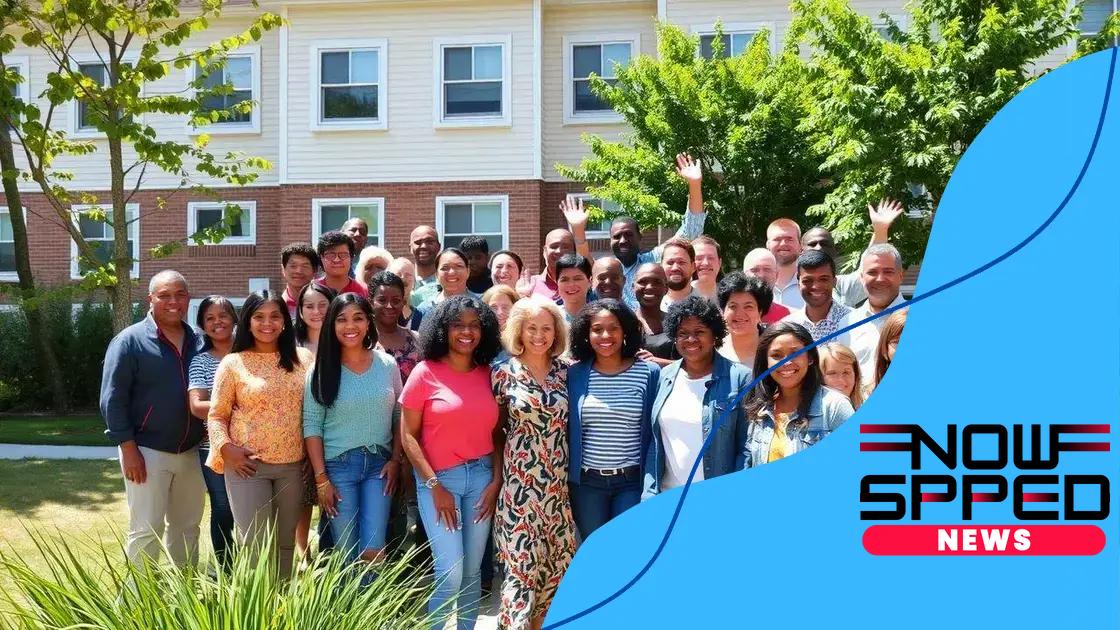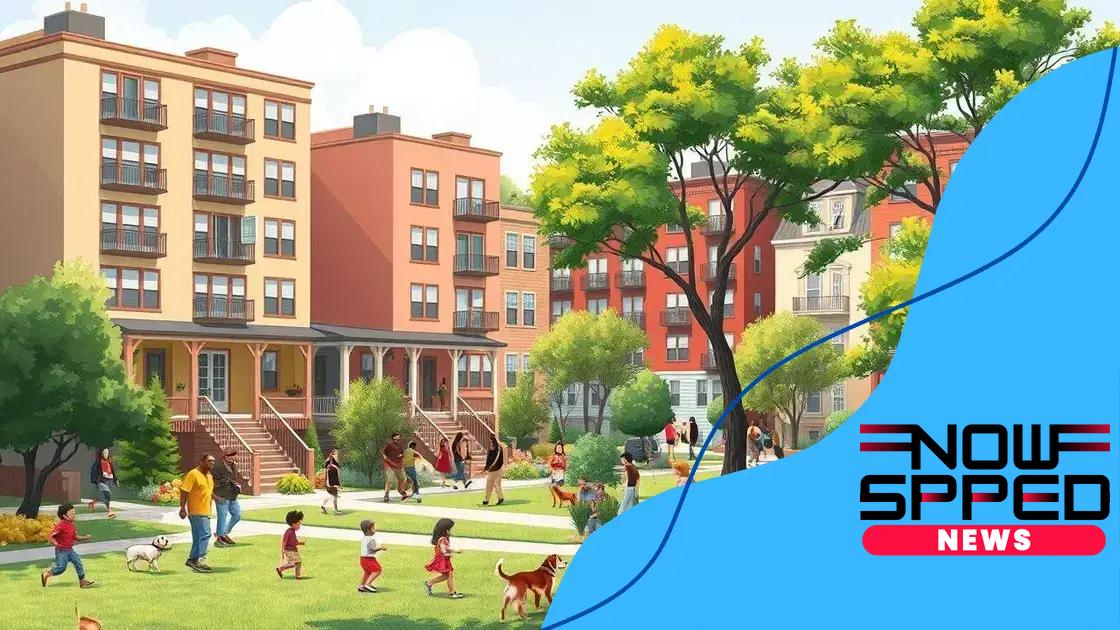Affordable housing support for disadvantaged groups is essential

Affordable housing support for disadvantaged groups is crucial for providing stable living conditions, addressing economic barriers, and ensuring access to essential resources through community involvement and government initiatives.
Affordable housing support for disadvantaged groups plays a crucial role in ensuring that everyone has a chance to thrive. Think about how a stable home can change lives and communities. Let’s explore what happens when we focus on this critical issue.
Understanding the need for affordable housing
Understanding the need for affordable housing is essential for creating thriving communities. Many families face challenges in finding safe and stable homes. This situation can impact not just their physical health but also their emotional well-being and financial stability.
Why Affordable Housing Matters
Affordable housing ensures that individuals and families can live in decent conditions without sacrificing their basic needs. It directly influences community health, education, and economic growth.
Key Factors of Affordable Housing
- Stability: A stable home environment promotes better health and education outcomes.
- Cost-effectiveness: Affordable housing reduces the burden on low-income families.
- Community development: Investing in affordable housing revitalizes neighborhoods.
Moreover, the availability of affordable housing plays a critical role in reducing homelessness. When housing costs rise, more families find themselves at risk of instability. The ripple effects of this crisis affect everyone in the community.
Access to quality education and employment opportunities often hinges on stable housing. When families can afford their homes, children have the chance to thrive. Programs aiming to improve affordable housing options often create job opportunities as well.
Consequences of Lack of Affordable Housing
The absence of affordable housing leads to increased economic disparities. Low-income families may have to spend a large portion of their income on housing, leaving less for other essential needs. This precarious situation can lead to cycles of poverty.
Furthermore, poor quality housing often correlates with health issues. Families living in inadequate conditions face numerous challenges, including exposure to hazards and limited access to necessary resources. Focusing on affordable housing can help mitigate these risks.
As we delve deeper into this topic, it becomes clear that understanding the need for affordable housing is vital for fostering a compassionate and successful society. It is not just about building homes; it is about building communities and sustaining lives.
Key challenges faced by disadvantaged groups
Disadvantaged groups face several key challenges when it comes to securing affordable housing. These obstacles can lead to difficult living conditions and a lack of stability, affecting their overall quality of life.
Economic Barriers
One significant challenge is economic constraints. Many individuals in disadvantaged groups struggle to find stable employment that pays enough to afford housing costs. Without a steady income, families often face the risk of eviction or homelessness.
Limited Access to Resources
- Adequate financial literacy programs are often lacking.
- Access to funding for housing is not readily available.
- Support services for job placement are frequently insufficient.
- Transportation options can be limited, making job access harder.
Another barrier is the lack of access to necessary resources. Programs designed to assist these groups are not always easy to navigate. This can leave many without the assistance they need to secure housing. Many find themselves caught in a cycle of poverty that is hard to break.
Social support networks are crucial, but often underdeveloped. Individuals from disadvantaged groups may lack connections to communities that provide job opportunities or information about housing options. This social isolation can further limit their chances of finding stable housing.
Discrimination in Housing
Discrimination also plays a role in the struggles faced by these groups. Many individuals encounter biases in the housing market that prevent them from accessing affordable housing. Landlords may be less likely to rent to them based on their socioeconomic status or background.
Moreover, the stigma associated with being part of a disadvantaged group can deter landlords from offering rentals. This creates further barriers to stable living conditions, making it even harder to overcome existing challenges.
Addressing these challenges is essential for improving the housing situation for disadvantaged groups. By understanding these issues, communities can work together to create solutions that support the creation of more affordable housing options.
Types of affordable housing solutions

There are various types of affordable housing solutions designed to meet the diverse needs of individuals and families. Understanding these options is crucial for addressing housing challenges faced by many.
Subsidized Housing
Subsidized housing provides financial assistance to low-income families. This support can come in the form of rent vouchers or reduced rents for public housing units. Such programs help alleviate the financial burden, making housing more attainable.
Housing Cooperatives
Housing cooperatives are another form of affordable housing. Residents collectively own the property and share responsibilities. This cooperative model encourages community involvement and can lower living costs.
Mixed-Income Developments
- These developments incorporate a variety of income levels.
- They aim to promote economic diversity within neighborhoods.
- Such settings foster social integration among residents.
- Funding often comes from public and private sources.
Mixed-income developments create environments where individuals from different economic backgrounds can live together. By combining affordable and market-rate units, these projects can reduce housing segregation.
In addition to these options, transitional housing is vital for those moving from homelessness to permanent housing. These temporary solutions offer individuals a stable environment while they secure more permanent residences.
Community Land Trusts
Community land trusts are established to ensure long-term access to affordable housing. These non-profit organizations acquire land and develop affordable housing while keeping prices stable. This model protects against market fluctuations and preserves housing affordability for future generations.
There are also inclusionary zoning policies that encourage developers to include affordable units in new constructions. By integrating affordable housing into market developments, these policies help create neighborhoods where socioeconomic diversity is valued.
Exploring various types of affordable housing solutions allows communities to adopt approaches that align with their needs and resources. Each solution plays a role in enhancing housing accessibility for disadvantaged populations.
Government programs supporting affordable housing
Government programs play a significant role in supporting affordable housing initiatives across various communities. These programs are designed to assist low-income families and individuals in securing stable housing.
Section 8 Housing Choice Voucher Program
One of the most well-known government programs is the Section 8 Housing Choice Voucher program. This program provides rental assistance to eligible families, allowing them to choose housing in the private market. Through this program, tenants typically pay 30% of their income towards rent while the government covers the remaining amount.
Public Housing Programs
Public housing programs offer affordable rental units to low-income families. These units are managed by local housing authorities and are often available at reduced rent. Many public housing developments also include support services to help residents with various needs.
Low-Income Housing Tax Credit (LIHTC)
- This federal program encourages developers to build affordable housing.
- It provides tax credits to reduce financial burdens.
- LIHTC units must remain affordable for a set period.
- Many states have programs that complement LIHTC.
The Low-Income Housing Tax Credit (LIHTC) program is another essential initiative. It incentivizes private developers to create affordable housing by offering tax credits. This program helps increase the overall supply of low-cost housing options, allowing more families access to safe and affordable living conditions.
Additionally, various state-level programs offer grants and financing options to support the development of affordable housing. These resources help local governments and non-profits build and maintain housing for low- and moderate-income families.
Community Development Block Grants (CDBG)
Community Development Block Grants (CDBG) are federal funds allocated to local governments to support housing and community development projects. Through CDBG, communities can receive funding to improve existing housing or create new affordable housing units.
These government programs are vital for addressing the housing crisis, especially for disadvantaged groups. By supporting innovative and varied approaches, they contribute to building stronger, more equitable communities.
Community involvement in affordable housing initiatives
Community involvement is crucial for the success of affordable housing initiatives. Engaging local residents in the planning and implementation processes helps ensure that the housing solutions meet the actual needs of the community.
Importance of Local Input
When communities are involved, their unique perspectives and ideas come to light. Local input can guide the design of housing projects to reflect the needs and desires of residents. This participation fosters a sense of ownership and pride in the development.
Building Community Partnerships
- Collaboration with local organizations strengthens resources.
- Partnerships can provide additional funding opportunities.
- Communities benefit from shared knowledge and expertise.
- Involvement increases network opportunities for residents.
Building partnerships with local organizations is another vital aspect. Non-profits, schools, and churches can support affordable housing initiatives by providing resources and helping with outreach efforts. These collaborations can lead to more successful projects that benefit those in need.
Community workshops and forums also serve as platforms for discussions about housing needs. Residents can share their experiences, express their concerns, and propose solutions, creating a more inclusive process. This engagement allows people to feel heard and enhances trust between the community and developers.
Volunteer Opportunities
Volunteer efforts can play a valuable role in making affordable housing initiatives successful. Community members may participate in construction, organizing events, or providing support services. Such involvement not only aids the projects but also builds lasting relationships among participants.
Moreover, encouraging volunteers from diverse backgrounds fosters a sense of unity within the community. People working together towards a common goal can strengthen neighborhood ties, making it easier to address additional local challenges.
Incorporating community involvement into affordable housing initiatives yields benefits that extend far beyond housing itself. It cultivates a collaborative mentality and creates more resilient and vibrant communities.
In conclusion, affordable housing is a vital issue that affects many people in our communities. By understanding the various types of solutions and the role of government programs, we can work together to create lasting change. Community involvement is essential in these initiatives, as it ensures that the voices of those most impacted are heard. Through collaboration, we can build stronger and more resilient neighborhoods, ultimately making affordable housing accessible to everyone. By focusing on these areas, we can turn challenges into opportunities for better living conditions for all.
\n
\n
FAQ – Frequently Asked Questions About Affordable Housing
What is affordable housing?
Affordable housing refers to housing units that are reasonably priced for low-income individuals and families, ensuring they can secure stable living conditions.
How can communities get involved in affordable housing initiatives?
Communities can participate through public meetings, volunteering for projects, and partnering with local organizations to support housing developments.
What government programs support affordable housing?
Programs like Section 8 housing vouchers and Community Development Block Grants provide essential assistance for low-income families to access affordable housing.
Why is community input important in housing projects?
Community input ensures that housing projects meet the actual needs of residents, fostering a sense of ownership and enhancing the project’s suitability for the local population.





